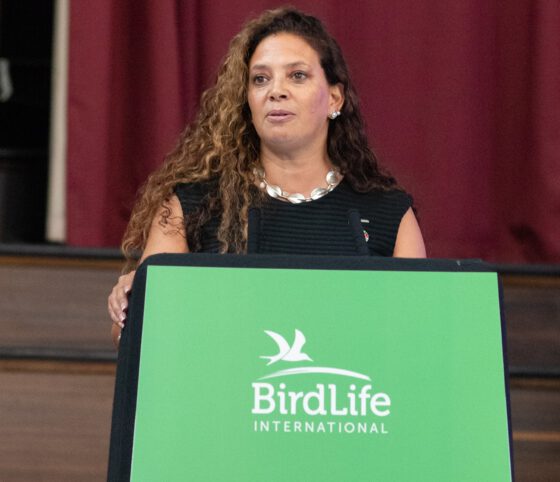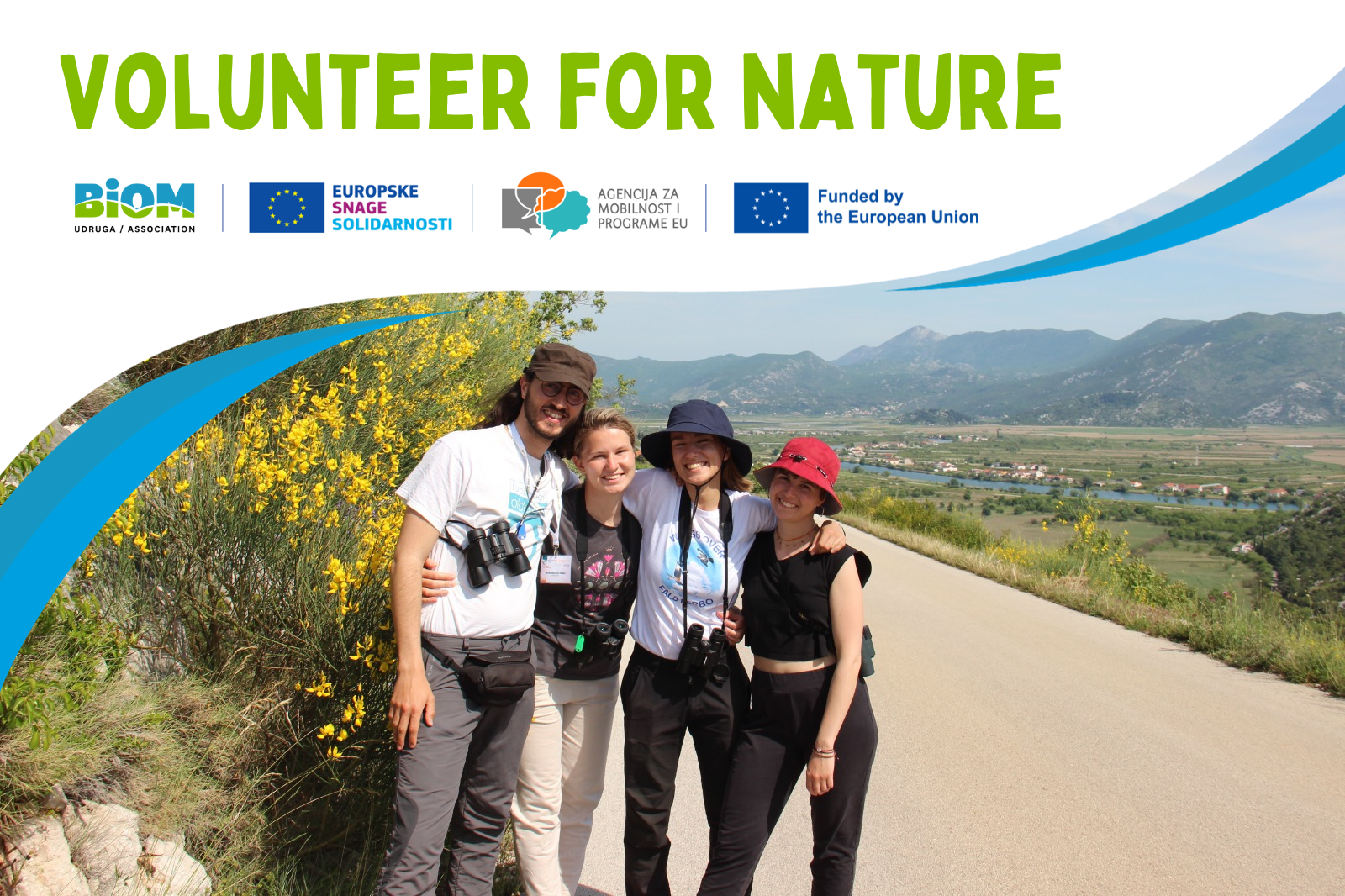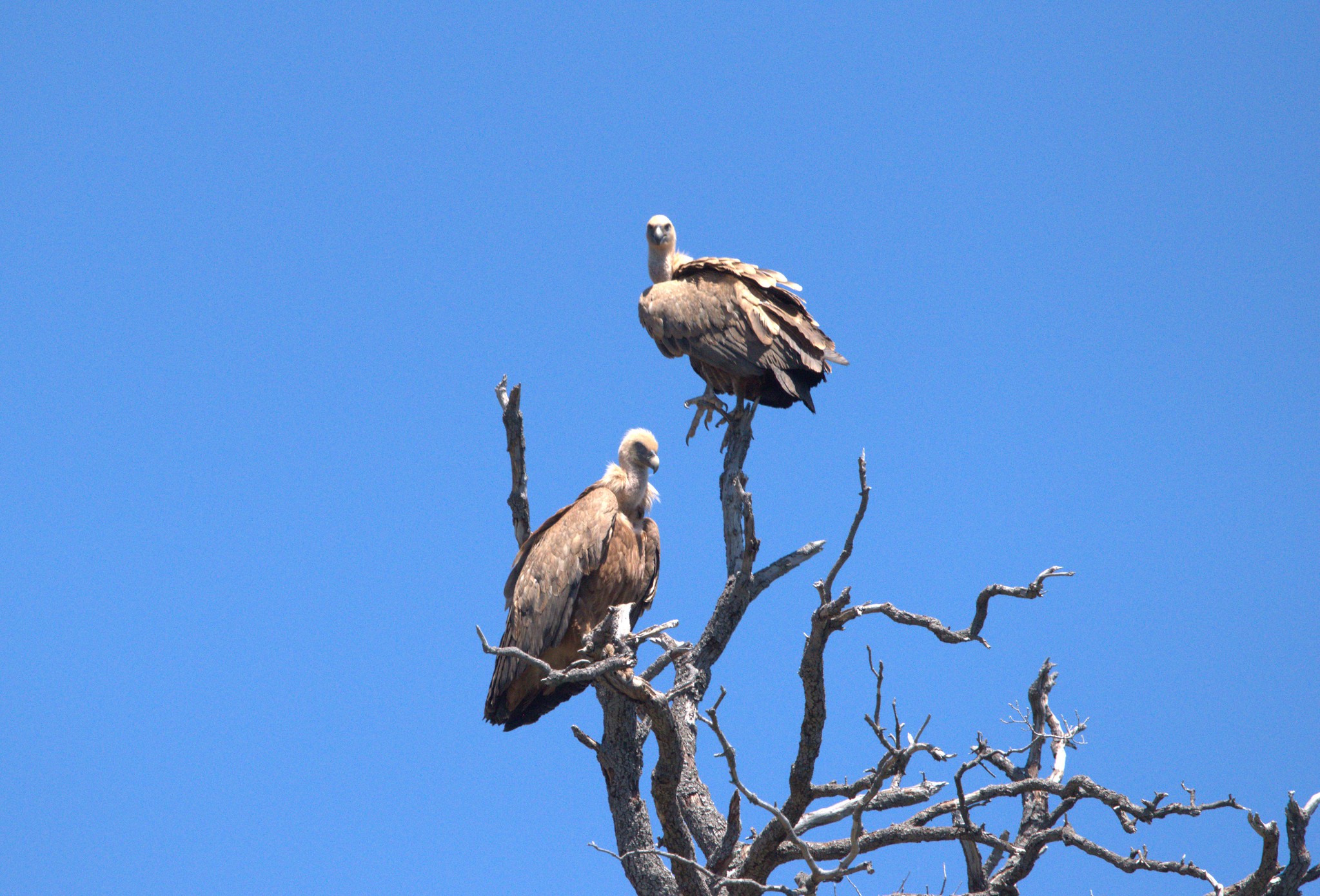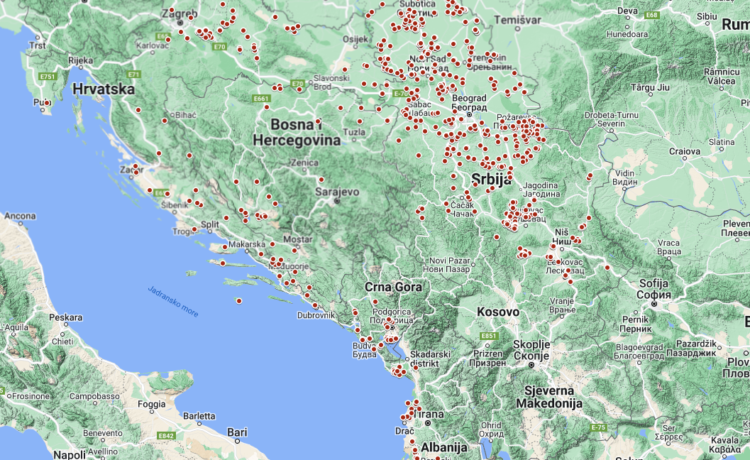A clear win is the 30×30 target – the commitment to protect and conserve 30% of land and of oceans by 2030

BirdLife International’s CEO
Patricia Zurita released the following statement on the newly approved Global Biodiversity Framework:
“The text of the global biodiversity framework released today thankfully has the clear mission to halt and reverse the loss of biodiversity by 2030. There are wins in the text for biodiversity conservation, for finance, for Indigenous peoples and local communities rights, and gender equality, with a commitment to take a human rights-based approach and recognition of the right to a healthy environment.
Though ambition on the critical elements of species and ecosystems is less clear cut, there are elements to commend. A clear win is the 30×30 target – the commitment to protect and conserve 30% of land and of oceans by 2030, which has finally landed in the framework after years of science, debate and horse-trading. The recognition that species declines need to be addressed in order to halt and reverse biodiversity loss is also a win – with a commitment to take urgent management action to halt species extinction and to substantially reduce extinction risk by 2030. Again, however, and disappointingly, no concrete measurable elements to hold us accountable appear.
The finance package includes elements which are positive, beginning to close the finance gap for nature. We need more and we need it faster. The finance package includes elements which sum to close the finance gap for nature, with a commitment to reducing subsidies by at least $500 billion by year by 2030 and to mobilise $200 million of finance from all sources, from private and public finance, with a pledge to raise $30 billion annually by 2030 through official development assistance. It is hoped the agreement of a new fund under the Global Environment Facility will unlock finances and channel funds to where funding is most needed.
Overall, these broad brush strokes are promising but we remain concerned about the inconsistencies in measurable elements across the framework. Without a concrete road map and verifiable timelines, we could be taking more steps back than forward.
We salute the governments for the all-night marathon efforts, and our partnership working in Montreal and around the globe with their national delegations, as well as our super Canadian partners for hosting us and pushing so hard.
We implore governments to begin urgently to act now. Let’s get a good night’s sleep, but then get to work. Implementation cannot wait a second more. Nature is gasping its last breath and we must immediately begin its resuscitation by delivering concretely on this agreement, and more.”
She was joined in her remarks by
Noelle Kumpel, Head of Policy, BirdLife International, who stated:
“We are pleased to see that the Kunming-Montreal Global Biodiversity Framework gavelled in the early hours of this morning has a clear mission to halt and reverse the loss of biodiversity by 2030. While not perfect, it represents a significant advance from the lengthy, muddled text with over 1400 brackets of yet-to-be-agreed text with which we started COP15 two weeks ago. Where measurable loss of reference to the right to a healthy environment in the early hours of yesterday set the tone for weakening ambition, and the text released today confirms this with the loss of all 2030 milestones from the goals, kicking the can down the road with no clear map on how to get to our final destination. We’re happy to see a strong target to protect and conserve 30% of the world’s land and ocean – focusing on key areas for biodiversity and recognising the rights of Indigenous People and local communities – but ambition and clarity seems to have slipped from other goals and targets in the process, including on addressing species declines and finance by 2030.”
And
Amy McDougall, Global Biodiversity Policy Coordinator, says:
“The fate of 1 million species at risk of extinction hangs in the balance. It may not be perfect but after an intense effort, from today the Global Biodiversity Framework provides us with a collective commitment to address species declines, alongside a strong target to protect and conserve 30% of the world’s land and ocean – focusing on key areas for biodiversity and recognising the rights of Indigenous People and local communities.”
Addendum
For very specific insights, BirdLife’s Chief Scientist,
Dr. Stuart Butchart, provided greater detail relating to the Goals and Targets, or lack thereof, in the framework.
“The Goals lack any 2030 milestones, so there are no defined biodiversity outcomes to be achieved by the end of the decade, which is very disappointing.
Goal A says ecosystem integrity must at least be maintained, effectively meaning no more loss of intact natural habitats but “substantially increasing the area of natural ecosystems by 2050” is too vague.
Goal A also commits to halting extinction of known threatened species (excellent!) and reducing extinction rate and risk 10-fold by 2050 (less ambitious than we had hoped, but OK). And increasing the abundance of native wild species to healthy & resilient levels (good but vague)
Goal A also commits to maintaining genetic diversity within populations of wild and domesticated species, which is pretty ambitious (though challenging to measure in practice.
Goals B, C & D have language on sustainable use, ecosystem services, equitable sharing of benefits, and financing – all OK but not very specific There are 23 targets for 2030. T1 is about spatial planning to bring the loss of areas of high biodiversity importance, including ecosystems of high ecological integrity, close to zero by 2030. “Close to” is a bit wishy-washy, but does imply no loss of Key Biodiversity Areas
T2 says 30% of areas of degraded ecosystems are “under effective restoration”. Pretty ambitious, but “degraded” and “effective” need defining and demonstrating, so this will be difficult to track.
T3 says 30% of areas, especially “of particular importance for biodiversity” are effectively conserved through protected areas etc. So, major expansion, but lack of mention of Key Biodiversity Areas risks more PAs in places that are cheap/easy to protect, as we saw since 2020
T4 commits to urgent management actions to halt human induced extinctions (excellent!) and to significantly reduce extinction risk (good but unspecific) & maintain/restore genetic diversity (good). So, we need to reverse the decline of the Red List Index.
Remaining targets focus on other threats (unsustainable use, invasives, pollution, climate change), benefits from nature, tools & solutions. The vague language on companies’ disclosure of biodiversity risks/impacts is weak.
T19 includes the commitment to mobilise $200 billion/yr to implement action (good), incl $30 billion/yr for developing countries by 2030 (far from enough).
Overall, the framework says lots of good things, but the lack of specifics and vague language in places is unhelpful. Ultimately it will all come down to implementation. If governments do all that they commit to here, the world will be a far better place – for people and nature.
 BirdLife International’s CEO Patricia Zurita released the following statement on the newly approved Global Biodiversity Framework:
“The text of the global biodiversity framework released today thankfully has the clear mission to halt and reverse the loss of biodiversity by 2030. There are wins in the text for biodiversity conservation, for finance, for Indigenous peoples and local communities rights, and gender equality, with a commitment to take a human rights-based approach and recognition of the right to a healthy environment.
Though ambition on the critical elements of species and ecosystems is less clear cut, there are elements to commend. A clear win is the 30×30 target – the commitment to protect and conserve 30% of land and of oceans by 2030, which has finally landed in the framework after years of science, debate and horse-trading. The recognition that species declines need to be addressed in order to halt and reverse biodiversity loss is also a win – with a commitment to take urgent management action to halt species extinction and to substantially reduce extinction risk by 2030. Again, however, and disappointingly, no concrete measurable elements to hold us accountable appear.
The finance package includes elements which are positive, beginning to close the finance gap for nature. We need more and we need it faster. The finance package includes elements which sum to close the finance gap for nature, with a commitment to reducing subsidies by at least $500 billion by year by 2030 and to mobilise $200 million of finance from all sources, from private and public finance, with a pledge to raise $30 billion annually by 2030 through official development assistance. It is hoped the agreement of a new fund under the Global Environment Facility will unlock finances and channel funds to where funding is most needed.
Overall, these broad brush strokes are promising but we remain concerned about the inconsistencies in measurable elements across the framework. Without a concrete road map and verifiable timelines, we could be taking more steps back than forward.
We salute the governments for the all-night marathon efforts, and our partnership working in Montreal and around the globe with their national delegations, as well as our super Canadian partners for hosting us and pushing so hard.
We implore governments to begin urgently to act now. Let’s get a good night’s sleep, but then get to work. Implementation cannot wait a second more. Nature is gasping its last breath and we must immediately begin its resuscitation by delivering concretely on this agreement, and more.”
She was joined in her remarks by Noelle Kumpel, Head of Policy, BirdLife International, who stated:
“We are pleased to see that the Kunming-Montreal Global Biodiversity Framework gavelled in the early hours of this morning has a clear mission to halt and reverse the loss of biodiversity by 2030. While not perfect, it represents a significant advance from the lengthy, muddled text with over 1400 brackets of yet-to-be-agreed text with which we started COP15 two weeks ago. Where measurable loss of reference to the right to a healthy environment in the early hours of yesterday set the tone for weakening ambition, and the text released today confirms this with the loss of all 2030 milestones from the goals, kicking the can down the road with no clear map on how to get to our final destination. We’re happy to see a strong target to protect and conserve 30% of the world’s land and ocean – focusing on key areas for biodiversity and recognising the rights of Indigenous People and local communities – but ambition and clarity seems to have slipped from other goals and targets in the process, including on addressing species declines and finance by 2030.”
And Amy McDougall, Global Biodiversity Policy Coordinator, says:
“The fate of 1 million species at risk of extinction hangs in the balance. It may not be perfect but after an intense effort, from today the Global Biodiversity Framework provides us with a collective commitment to address species declines, alongside a strong target to protect and conserve 30% of the world’s land and ocean – focusing on key areas for biodiversity and recognising the rights of Indigenous People and local communities.”
Addendum
For very specific insights, BirdLife’s Chief Scientist, Dr. Stuart Butchart, provided greater detail relating to the Goals and Targets, or lack thereof, in the framework.
“The Goals lack any 2030 milestones, so there are no defined biodiversity outcomes to be achieved by the end of the decade, which is very disappointing.
Goal A says ecosystem integrity must at least be maintained, effectively meaning no more loss of intact natural habitats but “substantially increasing the area of natural ecosystems by 2050” is too vague.
Goal A also commits to halting extinction of known threatened species (excellent!) and reducing extinction rate and risk 10-fold by 2050 (less ambitious than we had hoped, but OK). And increasing the abundance of native wild species to healthy & resilient levels (good but vague)
Goal A also commits to maintaining genetic diversity within populations of wild and domesticated species, which is pretty ambitious (though challenging to measure in practice.
Goals B, C & D have language on sustainable use, ecosystem services, equitable sharing of benefits, and financing – all OK but not very specific There are 23 targets for 2030. T1 is about spatial planning to bring the loss of areas of high biodiversity importance, including ecosystems of high ecological integrity, close to zero by 2030. “Close to” is a bit wishy-washy, but does imply no loss of Key Biodiversity Areas
T2 says 30% of areas of degraded ecosystems are “under effective restoration”. Pretty ambitious, but “degraded” and “effective” need defining and demonstrating, so this will be difficult to track.
T3 says 30% of areas, especially “of particular importance for biodiversity” are effectively conserved through protected areas etc. So, major expansion, but lack of mention of Key Biodiversity Areas risks more PAs in places that are cheap/easy to protect, as we saw since 2020
T4 commits to urgent management actions to halt human induced extinctions (excellent!) and to significantly reduce extinction risk (good but unspecific) & maintain/restore genetic diversity (good). So, we need to reverse the decline of the Red List Index.
Remaining targets focus on other threats (unsustainable use, invasives, pollution, climate change), benefits from nature, tools & solutions. The vague language on companies’ disclosure of biodiversity risks/impacts is weak.
T19 includes the commitment to mobilise $200 billion/yr to implement action (good), incl $30 billion/yr for developing countries by 2030 (far from enough).
Overall, the framework says lots of good things, but the lack of specifics and vague language in places is unhelpful. Ultimately it will all come down to implementation. If governments do all that they commit to here, the world will be a far better place – for people and nature.
BirdLife International’s CEO Patricia Zurita released the following statement on the newly approved Global Biodiversity Framework:
“The text of the global biodiversity framework released today thankfully has the clear mission to halt and reverse the loss of biodiversity by 2030. There are wins in the text for biodiversity conservation, for finance, for Indigenous peoples and local communities rights, and gender equality, with a commitment to take a human rights-based approach and recognition of the right to a healthy environment.
Though ambition on the critical elements of species and ecosystems is less clear cut, there are elements to commend. A clear win is the 30×30 target – the commitment to protect and conserve 30% of land and of oceans by 2030, which has finally landed in the framework after years of science, debate and horse-trading. The recognition that species declines need to be addressed in order to halt and reverse biodiversity loss is also a win – with a commitment to take urgent management action to halt species extinction and to substantially reduce extinction risk by 2030. Again, however, and disappointingly, no concrete measurable elements to hold us accountable appear.
The finance package includes elements which are positive, beginning to close the finance gap for nature. We need more and we need it faster. The finance package includes elements which sum to close the finance gap for nature, with a commitment to reducing subsidies by at least $500 billion by year by 2030 and to mobilise $200 million of finance from all sources, from private and public finance, with a pledge to raise $30 billion annually by 2030 through official development assistance. It is hoped the agreement of a new fund under the Global Environment Facility will unlock finances and channel funds to where funding is most needed.
Overall, these broad brush strokes are promising but we remain concerned about the inconsistencies in measurable elements across the framework. Without a concrete road map and verifiable timelines, we could be taking more steps back than forward.
We salute the governments for the all-night marathon efforts, and our partnership working in Montreal and around the globe with their national delegations, as well as our super Canadian partners for hosting us and pushing so hard.
We implore governments to begin urgently to act now. Let’s get a good night’s sleep, but then get to work. Implementation cannot wait a second more. Nature is gasping its last breath and we must immediately begin its resuscitation by delivering concretely on this agreement, and more.”
She was joined in her remarks by Noelle Kumpel, Head of Policy, BirdLife International, who stated:
“We are pleased to see that the Kunming-Montreal Global Biodiversity Framework gavelled in the early hours of this morning has a clear mission to halt and reverse the loss of biodiversity by 2030. While not perfect, it represents a significant advance from the lengthy, muddled text with over 1400 brackets of yet-to-be-agreed text with which we started COP15 two weeks ago. Where measurable loss of reference to the right to a healthy environment in the early hours of yesterday set the tone for weakening ambition, and the text released today confirms this with the loss of all 2030 milestones from the goals, kicking the can down the road with no clear map on how to get to our final destination. We’re happy to see a strong target to protect and conserve 30% of the world’s land and ocean – focusing on key areas for biodiversity and recognising the rights of Indigenous People and local communities – but ambition and clarity seems to have slipped from other goals and targets in the process, including on addressing species declines and finance by 2030.”
And Amy McDougall, Global Biodiversity Policy Coordinator, says:
“The fate of 1 million species at risk of extinction hangs in the balance. It may not be perfect but after an intense effort, from today the Global Biodiversity Framework provides us with a collective commitment to address species declines, alongside a strong target to protect and conserve 30% of the world’s land and ocean – focusing on key areas for biodiversity and recognising the rights of Indigenous People and local communities.”
Addendum
For very specific insights, BirdLife’s Chief Scientist, Dr. Stuart Butchart, provided greater detail relating to the Goals and Targets, or lack thereof, in the framework.
“The Goals lack any 2030 milestones, so there are no defined biodiversity outcomes to be achieved by the end of the decade, which is very disappointing.
Goal A says ecosystem integrity must at least be maintained, effectively meaning no more loss of intact natural habitats but “substantially increasing the area of natural ecosystems by 2050” is too vague.
Goal A also commits to halting extinction of known threatened species (excellent!) and reducing extinction rate and risk 10-fold by 2050 (less ambitious than we had hoped, but OK). And increasing the abundance of native wild species to healthy & resilient levels (good but vague)
Goal A also commits to maintaining genetic diversity within populations of wild and domesticated species, which is pretty ambitious (though challenging to measure in practice.
Goals B, C & D have language on sustainable use, ecosystem services, equitable sharing of benefits, and financing – all OK but not very specific There are 23 targets for 2030. T1 is about spatial planning to bring the loss of areas of high biodiversity importance, including ecosystems of high ecological integrity, close to zero by 2030. “Close to” is a bit wishy-washy, but does imply no loss of Key Biodiversity Areas
T2 says 30% of areas of degraded ecosystems are “under effective restoration”. Pretty ambitious, but “degraded” and “effective” need defining and demonstrating, so this will be difficult to track.
T3 says 30% of areas, especially “of particular importance for biodiversity” are effectively conserved through protected areas etc. So, major expansion, but lack of mention of Key Biodiversity Areas risks more PAs in places that are cheap/easy to protect, as we saw since 2020
T4 commits to urgent management actions to halt human induced extinctions (excellent!) and to significantly reduce extinction risk (good but unspecific) & maintain/restore genetic diversity (good). So, we need to reverse the decline of the Red List Index.
Remaining targets focus on other threats (unsustainable use, invasives, pollution, climate change), benefits from nature, tools & solutions. The vague language on companies’ disclosure of biodiversity risks/impacts is weak.
T19 includes the commitment to mobilise $200 billion/yr to implement action (good), incl $30 billion/yr for developing countries by 2030 (far from enough).
Overall, the framework says lots of good things, but the lack of specifics and vague language in places is unhelpful. Ultimately it will all come down to implementation. If governments do all that they commit to here, the world will be a far better place – for people and nature.






